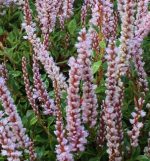 An Himalyan native, this semi-evergreen perennial is also called whortleberry-leaved knotweed and creeping fleeceflower and is a member of the knotweed family, Polygonaceae, that also includes dock, rhubarb, and buckwheat. Growing 6-12″ tall, it forms a dense mound of reddish stems carrying small glossy, ovate leaves that have red and gold tints in the fall. In late summer to early fall slender stems carry dense spikes or red to pink flowers. Rock knotweed is an excellent choice for a ground cover, edger, border, rock or wall garden. It flowers best in areas with cool evening temperatures. The genus name, Persicaria, comes from the Latin words persica meaning peach-like, and sagitta meaning arrow, and refers to appearance of the leaf of some species. The specific epithet, vaccinifolia, comes from the Latin Vaccinium, the genus of plants like blueberries, and folia, meaning leaf, and refers the similarity in appearance of the leaves of the two genera.
An Himalyan native, this semi-evergreen perennial is also called whortleberry-leaved knotweed and creeping fleeceflower and is a member of the knotweed family, Polygonaceae, that also includes dock, rhubarb, and buckwheat. Growing 6-12″ tall, it forms a dense mound of reddish stems carrying small glossy, ovate leaves that have red and gold tints in the fall. In late summer to early fall slender stems carry dense spikes or red to pink flowers. Rock knotweed is an excellent choice for a ground cover, edger, border, rock or wall garden. It flowers best in areas with cool evening temperatures. The genus name, Persicaria, comes from the Latin words persica meaning peach-like, and sagitta meaning arrow, and refers to appearance of the leaf of some species. The specific epithet, vaccinifolia, comes from the Latin Vaccinium, the genus of plants like blueberries, and folia, meaning leaf, and refers the similarity in appearance of the leaves of the two genera.
Type: Semi-evergreen perennial
Bloom: Spikes of small red to pink flowers in late summer to early fall
Size: 6-12″ H x 18-30″ W
Light: Full sun; tolerates some shade
Soil: Average, medium moist to dry, well-drained
Hardiness: Zones 6-8
Care: Cut back after flowering
Pests and Diseases: None of significance
Propagation: Division in spring or fall
Companion Plants: Bloody cranesbille, Caucasian crosswort, Origanum ‘Kent Beauty’